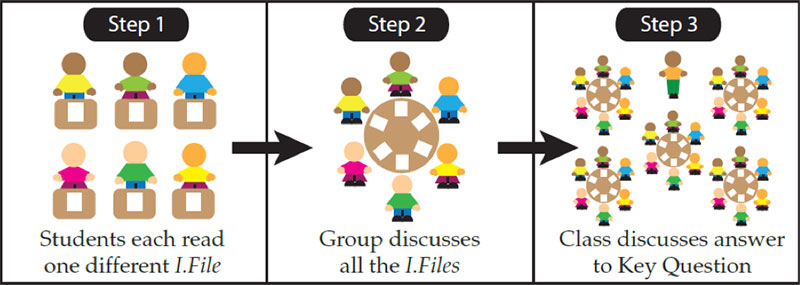In our Experience Science A-Z series, we show you what it’s like to use Science A-Z to teach science through reading and reading through science. In Part 1, we put you in the shoes of a teacher facilitating a lesson with Investigation Packs: group science activities for in-depth explorations of STEM content that help students practice 21st century skills.
Preparing for Scientific Inquiry
You’ve printed the day’s materials and arranged the seating to accommodate small group activities where students will close-read the Machines Investigation Pack, which consists of 4 Investigation Files (I.Files) and a Mystery File.
Each group has I.Files at Low, Mid, and High levels, so every student has an opportunity to read about machines and collaborate to answer the Key Question: What do all complex machines have in common?
When your students enter, you greet them, group them, and explain the goal for the lesson: reading I.Files to solve a mystery about what makes a complex machine.
Guiding Group Activities
Once students have taken their seats you assign each student a role: recorder, discussion leader, materials collector, timekeeper, and fact checker.
Then, you ask students to read their own I. File and collect evidence on his/her I. File Response Sheet, listing details that are important for answering the Key Question.

As students read independently, you visit each group and ask students if they have any questions about vocabulary or new concepts. After 20 minutes of students reading and completing the Response Sheet, you ask the groups discuss what their I.Files had in common and collaborate to answer the Key Question.
When students have shared ideas with their group members, you lead a class discussion that pulls together students’ observations to reach to a consensus on the answer to the Key Question.
You write their ideas on the board and then ask students to use close-reading strategies and participate in scientific, text-based argument to solve the Mystery File’s question: Are army ants complex machines?
Bringing It All Together
After students read the Mystery File on their own, you project it on the whiteboard and ask students to come up and highlight text evidence that points toward their group’s answer.
Finally, you ask students to complete their Mystery File response sheet with the answers and evidence you discussed.
Stay tuned for Part 2
Learn to coordinate a hands-on Process Activity in which students apply the concepts they analyzed today to design a machine.
Want to try Science A-Z in your classroom?
Get a closer look at Science A-Z’s printable, projectable, and digital STEM resources with a free trial today!


